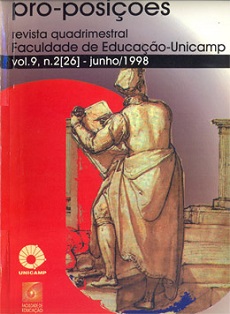Resumo
este artigo, oferecido a professores que suspeitam que as inibições das crianças em relação ao gênero impedem a aprendizagem em ambientes coeducacionais, descreve como meninos e meninas encontraram solos comuns em um programa de dança e educação australiano. A autora discute como o uso de máscaras nas aulas de dança para crianças em idade pré-escolar pode transformar comportamentos e idéias estereotipadas sobre gênero presentes nas aulas de dança através da modificação do uso e das escolhas de movimento com finalidade criativa. Para isto, apresenta dados de pesquisa qualitativa realizada durante 15 semanas em ambiente escolar e as possibilidades abertas através do uso de uma metodologia multimediática.
Abstract:
this article, offered to teachers who have suspected that children's gender inhibitions impede learning in coeducational settings, describes how boys and girls found a commom ground in Australian dance education programo The author discusses how the use of props in dance classes through creative movement can change behaviour and pre conceived ideas about gender often present in dance classes in school environment. ln this article she shares some findings of her research in school setting based on qualitative analysis, giving emphasis to a a possibility of making use of a methodology thant inlcudes multimedia approaches.
Descriptors: Gender. Dance. Education, Movement,. Children
Referências
Alexanderson, M. (1993). R~flection on working methods. Trabalho apresentado em reunião do Tertiary Arts Group, da Victoria University ofTechnology, Melbourne.
Ariés, E. (1987). Gender and communication. In: P. Shaver e C. Hendrick (orgs.). Sex and gender. Newbury Park: Sage Publications.
Bleier,R.(1984).Science and gendel:' A critique qlhiology and í/slheories on u:omen. NovaYork: Pergamon. .
Bond, K. E. (1991).Danceforchildren with dualsensory impairments. Tesede doutorado. Universidade de La Trobe, Bundoora.
Byatt, A. (1990). Possession: A romance. Londres: Vintage Books.
Clark, M. (1990). The great divide: Gendé in lhe primaJY school. Melbourne: Curriculum Corporation.
Davies,B.(1989).Frogsand snails andfeminist lales:Pre-school children and gender. Sydney:Allen e Unwin.
DeU,C.(1977).Aprimel/or l1wvement description using f!/Tol1-shapeand supplementary concepts.
a. ed. Nova York: Dance Notation Bureau.
Doty, W. (1986). Mylhography: The study ql myths and rituais. Universidade de Alabama: University of Alabama Press.
Exiner,J.eLIoyd,P.(1973).Teacbing creative movement. Sydney:Anguse Robertson.
Furuido, H. (1993). Expressions of femininity by male actors: On representations of love in Noh, Kabuki, and Bunraku. In: Proceedings q!thejapan-Asia Dance Event. Tóquio: JADE 93.
Crimes,R. (1982).Beginnings in ritual studies. Lanham: University Press of America.
Hanna, J.(1987).Todance isbuman: A theory q! nonverbal coml1llmication. 2a.ed.Chicago: University of Chicago Press.
Johnson, L. (1990).Cender issues and education, Australian Feminists Studies 2, pp. 17-27.
Laban, R. (1960).Maste/y q! movement. 2a. ed. Londres:Macdonald e Evans.
Lott,B. (1987).Women~, lives' 17Jemesand variations in gender learning. PacificCrave,Califómia: BrooksjCole.
Sendak,M.(1963).Wbere tbe lVi/dthings are. NovaYork:Harper and Row.
Stanworth, M. (1983).Gender and schooling: A study q!sexual divisions in the classroom. Londres: Hutchinson and Co.
Stinson, S.; Blumenfeld-Jones, D. e Van Dyke, J. (1990).Voices of young women dance students:An interpretative study of meaning in dance,Dance Researcbjournal22 (2), pp. 13-22.
Tumer,V.(1969).7he ritual process: Structure and anti-structure. Londres:Routledge and Kegan Paul.
Tumer,V.(1982).From ritual to theatre: 77.Jebuman seriousness q!play. Nova York:Performing Arts Journal Publications.
Zammuner, V.(1987). Children's sex-role stereotypes: A cross-cultural analysis. In: P. Shaver e C. Hendrick (orgs.). Sex and gender. Newbury Park: Sage Publications.
A Proposições utiliza a licença do Creative Commons (CC), preservando assim, a integridade dos artigos em ambiente de acesso aberto.

